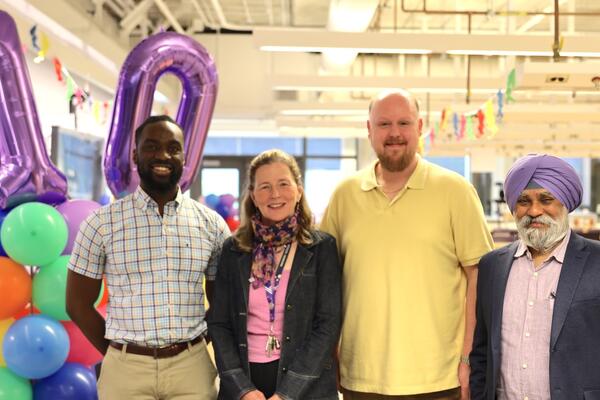
Engineers for Hope tackle tough global problems
The ambitious plan was born during a conversation on a bus by Engineering students

The ambitious plan was born during a conversation on a bus by Engineering students
By Emily Lucke Faculty of EngineeringAn otherwise ordinary outing produced exceptional results when six engineering classmates at the University of Waterloo travelled to nearby Hamilton in the summer of 2015 to explore waterfalls and escarpments.
“We were on the bus, discussing world tragedies,” recalls Adnan Abu Atiya, a fourth-year civil engineering student. “As a group, we realized that every individual in the world has their own story. Using engineering management we wanted to help improve as many of those stories as possible. That’s when the idea of Engineers For Hope (EFH) was born.”
The ambitious plan – channeling their individual skills and passions into “developing innovative designs and sustainable techniques to enhance living conditions in developing countries” – was inspired by first-hand understanding of the day-to-day challenges faced by much of the world’s population.
Atiya and her five engineering classmates – Tariq Hasan, Rumman Rahman, Shihab Saadeldeen, Nirbhay Singh and Youssef Zak – have all lived in at least one developing country, including India, Bangladesh, Egypt, Palestine, and Jordan.
“The team sees through two lenses,” says Singh. “The technical engineering lens and the social lens, which is knowing what it is like to live in a developing country.”
In the fall of 2015, the six students officially founded the Engineers for Hope Student Design Team, the newest group based in the Sedra Student Design Centre. At the same time, they reached out to Nandita Basu, a civil and environmental engineering professor, to act as their advisor.
“Professor Basu is a member of the University’s Water Institute, is from India and works in developing countries, so she was a natural fit to advise us,” says Singh. “Being part of the Sedra Student Design Centre is prestigious. We have access to resources and exposure.”
The team’s next step was partnering with local non-governmental organizations (NGOs) in parts of the world where they hope to help. While visiting family in Bangladesh, for instance, Rahman approached a local NGO called Sjouk with the idea of providing civil engineering assistance on projects that would make a difference.
Less than a year after that initial discussion on the bus, the six-member student design team is now getting ready to launch its pilot project in partnership with Sjouk and a local civil engineer. Eight shallow-hand tube wells and eight double-pit sanitary latrines engineered by EFH are to be constructed in August in Rahman’s hometown, the village of Khukshia, where clean water sources and sanitation are scarce.
“Most of us take these things for granted,” Singh says. “But in Bangladesh, it’s a very big deal to build a $165 toilet when most households make under $3.30 a day.”
Singh cites the entrepreneurial culture at Waterloo Engineering as a critical factor in the formation of the team.
“Having this legacy of University of Waterloo alumni who do so well gives us a positive feeling,” he says. “At Waterloo Engineering, we don’t just talk – we act.”
You can help with this project by donating to the EFH Bangladesh Water Sanitation Project.

Read more
The Waterloo community comes together to remember, reflect and respond to gender-based violence

Read more
Shop Canadian this holiday season with festive porch plants, fashion-forward apparel, craft spirits and more from Waterloo entrepreneurs

Read more
The Pearl Sullivan Engineering IDEAs Clinic marks a decade of delivering experiential learning embedded in the real world and mentored by industry professionals
The University of Waterloo acknowledges that much of our work takes place on the traditional territory of the Neutral, Anishinaabeg, and Haudenosaunee peoples. Our main campus is situated on the Haldimand Tract, the land granted to the Six Nations that includes six miles on each side of the Grand River. Our active work toward reconciliation takes place across our campuses through research, learning, teaching, and community building, and is co-ordinated within the Office of Indigenous Relations.